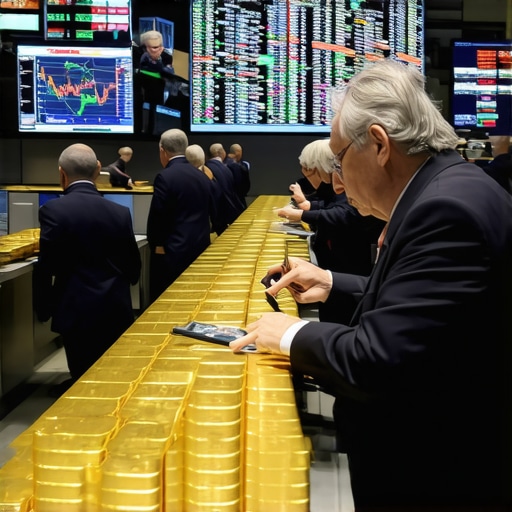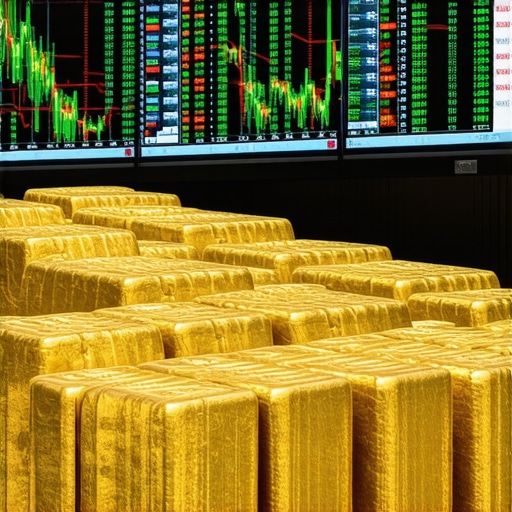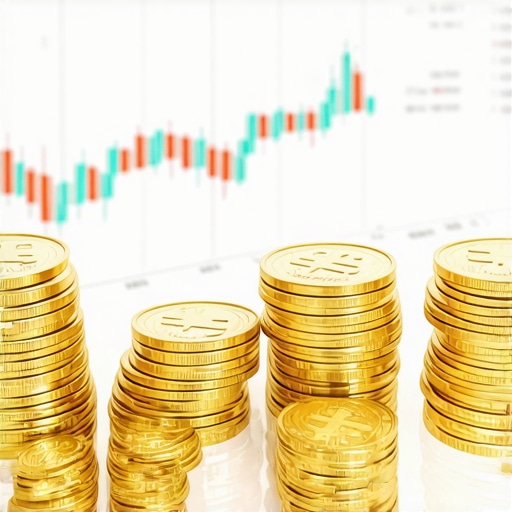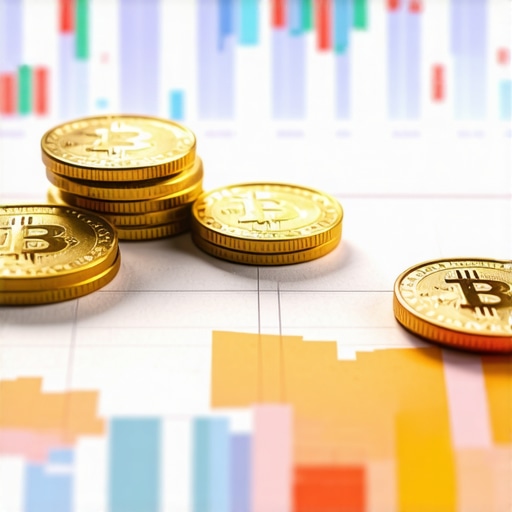Decoding the 2024 Gold Market: An Expert Perspective on Supply, Demand, and Price Dynamics
As we approach 2024, understanding the intricacies of the gold market becomes paramount for investors seeking to safeguard and expand their wealth. Gold, long celebrated as a safe-haven asset, is influenced by a complex interplay of macroeconomic factors, geopolitical tensions, and central bank policies. This analysis synthesizes expert insights, market trends, and emerging drivers to equip discerning investors with actionable intelligence.
Thematic Shifts in Gold Demand: Jewelry, Investment, and Industrial Uses
Recent studies indicate a nuanced shift in gold demand channels. While jewelry consumption remains resilient in emerging markets, the surge in gold ETFs and institutional holdings signals a strategic pivot among investors. Additionally, industrial applications, notably in electronics and renewable energy, are expected to influence supply-demand balances significantly in 2024. Understanding these shifts is vital for predicting price trajectories and identifying entry points.
Central Bank Gold Purchases: The Hidden Catalyst for 2024 Market Movements
Central banks are increasingly reclaiming gold reserves as part of their strategic diversification, impacting global liquidity and price stability. According to reports from the World Gold Council, central banks’ net gold purchases reached notable levels in recent quarters, signaling an institutional shift towards gold as a hedge against geopolitical risks and fiat currency volatility. For investors, monitoring these policy moves offers clues to future price support and volatility patterns.
What Are the Long-Term Implications of Central Bank Gold Accumulation for Private Investors?
This question reflects a core concern among market participants. Historically, central bank buying has been a bullish indicator for gold, often preempting sustained bullish cycles. However, the timing and scale of these purchases require careful analysis, considering potential market saturation or shifts in monetary policy. Exploring this dynamic can reveal opportunities for tactical positioning and risk mitigation.
Emerging Trends and Future Price Drivers in 2025
Looking beyond 2024, emerging demand trends—such as increased investment in gold-related ETFs, technological innovations in gold extraction, and geopolitical tensions—are poised to shape prices into 2025. Expert analyses suggest that gold’s role as an inflation hedge remains critical amid ongoing monetary easing and fiscal uncertainties. For a comprehensive forecast, investors should consider macroeconomic indicators, currency movements, and geopolitical stability.
For those aiming to optimize their gold portfolio, strategic diversification across physical gold, ETFs, and mining stocks is advisable. Our detailed analysis of emerging demand trends and supply constraints can be found here.
Enhancing Your Gold Investment Strategy in 2024 and Beyond
Developing a resilient gold investment strategy involves assessing market volatility, understanding technical analysis tools, and aligning with long-term financial goals. Effective techniques include leveraging futures contracts, gold mining equities, and diversified ETFs. For tailored guidance, consult our comprehensive resources or engage with industry experts.
Explore our article on maximizing gold investment returns through strategic trading to refine your approach.
As market conditions evolve, staying informed through authoritative sources like the World Gold Council can provide valuable insights into global trends and policy impacts affecting gold prices.
Deciphering the Long-Term Impact of Central Bank Gold Accumulation
As global economic uncertainties persist, central banks are increasingly turning to gold as a strategic reserve asset. This trend, driven by concerns over fiat currency stability and geopolitical risks, has significant implications for private investors aiming to navigate the evolving market landscape.
Historically, central bank gold purchases have acted as a bullish signal, often preceding sustained upward trends in gold prices. According to a comprehensive analysis by the World Gold Council, these holdings serve as a vote of confidence in gold’s role as a safe haven amid currency devaluations and inflationary pressures. As central banks diversify their reserves, their accumulating gold positions can create a ripple effect, bolstering demand and supporting prices in the long run.
How Will Central Bank Gold Buying Influence Private Investment Strategies in 2025?
This question prompts a nuanced evaluation of how institutional actions intersect with individual investment decisions. For instance, ongoing central bank purchases may signal an impending supply crunch, making physical gold and ETFs more attractive options. Conversely, excessive accumulation could lead to market saturation, requiring investors to adopt more sophisticated strategies such as leveraging futures or mining stocks for diversification.
Moreover, understanding the geopolitical context—like rising tensions or shifts in monetary policy—can help investors anticipate potential price catalysts. For detailed insights on developing a resilient gold portfolio, explore our guide on developing a profitable gold investment strategy for 2025.
To stay ahead, expert analysis suggests monitoring central bank reports, treasury disclosures, and macroeconomic indicators, including inflation rates and currency fluctuations. These elements collectively influence the supply-demand dynamics, shaping the trajectory of gold prices into 2025 and beyond.
Emerging Demand Drivers and Market Dynamics for 2025
Beyond central bank activity, other emerging factors such as technological advancements in gold extraction, increasing interest in gold-backed digital assets, and geopolitical tensions are poised to influence market dynamics. For instance, innovations like environmentally sustainable mining techniques could alleviate supply constraints, while geopolitical conflicts may heighten demand for tangible assets like gold.
Investors seeking a strategic edge should consider diversifying across physical gold, ETFs, and mining equities. Our comprehensive analysis of future demand drivers and supply constraints can be found here.
Additionally, understanding the interplay of macroeconomic variables—such as inflation trends, currency strength, and fiscal policies—can enhance timing and allocation decisions, ultimately maximizing portfolio resilience in volatile markets.
Unlocking Expert-Driven Investment Frameworks for 2025
For seasoned investors, establishing a robust gold strategy involves integrating technical analysis, market sentiment, and geopolitical risk assessments. Techniques like futures trading, options hedging, and leveraging mining stocks can optimize returns while managing downside risks. To refine your approach, check out our resource on effective gold trading techniques for 2025.
Stay informed through authoritative sources such as the World Gold Council for up-to-date insights into global demand trends and policy impacts. These insights are vital for constructing a flexible, forward-looking investment plan that adapts to changing market conditions and harnesses emerging opportunities in the gold sector.
Central Bank Gold Accumulation: A Catalyst for Future Market Volatility and Stability
As central banks continue to augment their gold reserves, the implications extend far beyond simple reserve diversification. The strategic accumulation of gold by these institutions is often viewed as a barometer of geopolitical confidence and macroeconomic stability. This trend, meticulously documented by the World Gold Council, reveals a nuanced narrative: central banks are hedging against fiat currency devaluation and geopolitical tensions, which could influence global liquidity and investor sentiment for years to come.
From an investment perspective, understanding the scale and timing of these central bank actions enables investors to anticipate potential supply shortages. Historically, sustained central bank buying has been a bullish signal, often heralding a long-term rally in gold prices. However, the scale of accumulation can also introduce market saturation, which may temper short-term gains. Therefore, discerning the strategic motives behind these purchases—whether defensive or opportunistic—is essential for crafting resilient investment strategies.
What Are the Nuanced Market Signals Indicating an Inflection Point in Central Bank Gold Buying?
This sophisticated inquiry delves into the subtle indicators that precede shifts in central bank behaviors. Experts suggest monitoring official disclosures, such as treasury reports and reserve updates, alongside macroeconomic variables like inflation rates, currency stability, and geopolitical developments. A surge in gold purchases amid rising geopolitical tensions often signals a defensive posture, whereas tapering might indicate a stabilization phase or a shift towards other reserve assets. Advanced investors leverage these signals through algorithms and machine learning models, integrating multiple data streams to forecast the next phase of market movements.
For a comprehensive understanding, review the detailed analysis provided by the World Gold Council on the strategic implications of central bank reserve management.
Technological Innovations and Policy Shifts: New Frontiers in Gold Market Dynamics
As the gold market evolves, technological advancements in extraction and digitization are poised to alter supply-demand equations profoundly. Environmentally sustainable mining techniques—such as bio-mining and automation—promise to mitigate supply constraints, making gold more accessible and reducing costs. Concurrently, the advent of gold-backed digital assets, including blockchain-based tokens, introduces new avenues for liquidity and portfolio diversification. These innovations, highlighted by industry leaders in reports like Gold Technology Innovations, could catalyze market shifts in the coming years.
Moreover, policy shifts—such as changes in import/export tariffs, environmental regulations, or monetary policies—will further influence market dynamics. Investors should stay vigilant by tracking legislative developments and technological breakthroughs, which could either constrain or expand gold’s role as a safe-haven asset.
How Can Investors Effectively Integrate Technological and Policy Trends Into Their Gold Strategies?
This question emphasizes the importance of a multi-dimensional approach to gold investing. Diversification across physical gold, ETFs, and emerging digital assets, combined with active monitoring of legislative and technological developments, can enhance portfolio resilience. Utilizing predictive analytics and scenario planning enables investors to adapt swiftly to evolving market conditions. Engaging with industry reports, expert webinars, and analytical tools—such as those offered by the World Gold Council—can provide a competitive edge.
Ultimately, integrating these forward-looking insights fosters a proactive investment stance, positioning portfolios to capitalize on upcoming opportunities and mitigate risks associated with technological disruptions and policy changes.
Deciphering Evolving Market Dynamics: How Geopolitical Risks and Monetary Policies Shape Gold’s Trajectory
The intricate relationship between geopolitical tensions and central bank monetary policies continues to be a pivotal factor influencing gold prices in 2024. With rising tensions in key regions and shifting interest rates globally, investors must analyze how these elements interact to create volatility or stability in the gold market. For instance, increased geopolitical conflicts often prompt safe-haven demand, while aggressive interest rate hikes can suppress gold’s appeal due to higher opportunity costs.
Unveiling the Impact of Digital Transformation and Blockchain Integration in Gold Trading
The advent of blockchain technology and digital assets is revolutionizing gold trading and ownership. Gold-backed tokens and blockchain-based custody solutions enhance transparency, reduce transaction costs, and facilitate fractional ownership, thus broadening access to institutional and retail investors. Industry reports, such as those from the World Gold Council, highlight how technological innovation is creating new liquidity channels and risk management tools within the gold sector.
How Are Supply Chain Disruptions and Sustainable Mining Practices Reshaping Gold Availability?
Recent disruptions in global supply chains, compounded by stricter environmental regulations, have prompted a paradigm shift toward sustainable mining practices. Innovations such as bio-mining, automation, and eco-friendly extraction methods not only mitigate environmental impact but also influence supply patterns and costs. These developments are critical for investors assessing long-term supply constraints and price stability, as outlined by industry specialists in reports like Gold Technology Innovations.
What Advanced Analytical Techniques Are Leading to Better Market Forecasting?
Utilizing machine learning algorithms, big data analytics, and sentiment analysis provides a competitive edge in predicting gold price movements. These sophisticated tools integrate macroeconomic indicators, geopolitical developments, and market sentiment to identify potential inflection points with higher accuracy. For example, algorithmic models that analyze official reserve reports and macroeconomic data can flag emerging trends before they become apparent to the broader market, empowering investors with actionable insights.
In What Ways Can Investors Leverage Diversification to Mitigate Risks in a Volatile Gold Market?
Strategic diversification across physical gold, ETFs, mining stocks, and digital assets is essential for risk management. Combining these instruments allows investors to hedge against various market scenarios, from supply shocks to currency fluctuations. Furthermore, incorporating options and futures contracts can provide leverage and downside protection. Expert guidance suggests a dynamic asset allocation approach, continually adjusted based on evolving market signals and macroeconomic forecasts.
Conclusion: Embracing a Multi-Faceted Approach for Future-Proof Gold Investment Strategies
As the gold market becomes increasingly complex with technological, geopolitical, and environmental shifts, adopting an integrated, forward-looking investment strategy is imperative. Continuous monitoring of technological innovations, policy changes, and market sentiment, coupled with advanced analytical tools, will position investors to capitalize on emerging opportunities while managing risks effectively. For in-depth guidance, consult authoritative sources such as the World Gold Council and leverage expert insights to refine your portfolio for sustained resilience and growth in 2024 and beyond.
Expert Insights & Advanced Considerations
Strategic Reserve Diversification
Leading analysts emphasize that central bank gold accumulation is not merely reserve management but a strategic hedge against geopolitical and economic uncertainties. Monitoring reserve disclosures can provide foresight into long-term price trends and market stability.
Technological Disruption and Supply Chain Innovation
Advancements in sustainable mining and blockchain integration are transforming gold supply chains. Investors should consider how these innovations may reduce costs, increase transparency, and influence supply-demand dynamics in the coming years.
Market Sentiment and Data-Driven Forecasting
Utilizing big data analytics, sentiment analysis, and machine learning models enhances forecasting accuracy. Incorporating macroeconomic variables alongside geopolitical developments allows for more nuanced investment decisions in volatile markets.
Geopolitical and Monetary Policy Interplay
The relationship between rising geopolitical tensions and monetary policy shifts directly impacts gold’s role as a safe haven. Staying informed on policy changes and conflict zones helps anticipate market volatility and investment opportunities.
Digital Transformation in Gold Trading
Blockchain technology and gold-backed tokens are expanding liquidity and accessibility. These innovations facilitate fractional ownership and reduce transaction costs, requiring investors to adapt their strategies accordingly.
Curated Expert Resources
- World Gold Council: The definitive authority for market research, policy analysis, and demand-supply insights, essential for strategic decision-making.
- Gold Technology Innovations Reports: Industry-leading publications detailing sustainable mining, blockchain integration, and technological advances shaping future supply chains.
- Market Data Platforms: Advanced analytics platforms offering macroeconomic data, geopolitical risk assessments, and sentiment analysis to inform tactical investments.
- Industry Webinars & Expert Panels: Regular sessions featuring market leaders discussing emerging trends, policy impacts, and technological breakthroughs in gold investing.
- Academic and Policy Research Papers: In-depth studies on the long-term implications of central bank reserves and geopolitical risk on gold markets, providing a scholarly perspective for sophisticated investors.
Final Expert Perspective
In navigating the evolving gold market, integrating expert insights on supply chain innovations, geopolitical risks, and technological advancements is crucial for a resilient investment strategy. Staying ahead requires continuous learning, leveraging authoritative resources, and adopting a multi-faceted approach to maximize growth and mitigate risks. To deepen your understanding, explore our comprehensive resources and consider engaging with industry specialists—your strategic foresight begins here.










